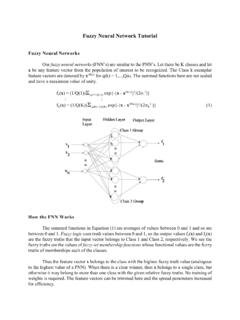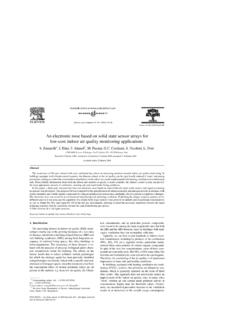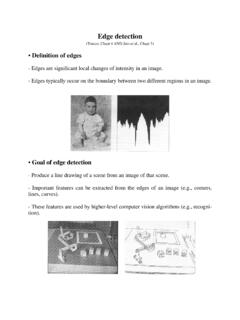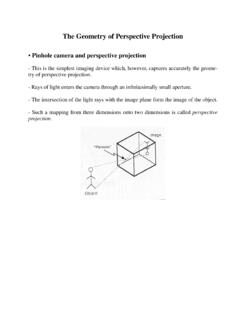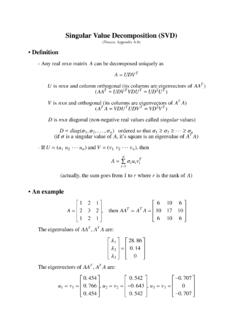Transcription of Paradigm shift— an introduction to fuzzy logic
1 6 IEEE POTENTIALS0278-6648/06/$ 2006 IEEEFUZZY logic SUGGESTS inaccuracyand imprecision. Webster s dictionarydefines the word fuzzy as not clear,distinct, or precise; blurred. In a broadsense, fuzzy logic refers to fuzzy sets,which are sets with blurred boundaries,and, in a narrow sense, fuzzy logic is alogical system that aims to formalizeapproximate logic is an approach to comput-er science that mimics the way a humanbrain thinks and solves problems. Theidea of fuzzy logic is to approximatehuman decision making using naturallanguage terms instead of quantitativeterms. It is formally defined asa form of knowledge rep-resentation suitable fornotions that cannot bedefined precisely, but whichdepend upon their contexts. Itenables computerized devicesto reason more like technology has createda Paradigm shift evident through manyscientific and industrial , did it begin with fuzzy ?
2 Interestingly, fuzzy science start-ed in the questioning minds ofphilosophers. Confused and inquisi-tive, from Buddha, to Aristotle, toPlato, these ancient philosopherswere constantly searching for a ruleof law beyond true or that computer logicwas incapable of representing sub-jective ideas such as very hot or very cold, in 1965, Zadeh pub-lished his ideas of fuzzy set theorythat made it possible for computersto distinguish between differentshades of gray, similar to theprocess of human reasoning. Hedescribed fuzzy mathematics, devisingprecise rules for combining vagueexpressions such as somewhat fast, very hot, and usually wrong, whichare particularly useful for controllingrobots, machine tools, and variouselectronic Terano was inspired byZadeh s work and introduced fuzzylogic to the Japanese scientific commu-nity in 1972.
3 As Bart Kosko, a Zadehprot g and a professor of electricalengineering at the University ofSouthern California said: Fuzzinessbegins where Western logic ends. Japan embraced the technology andadapted it to physical control 1980, Smidth & Co. ofCopenhagen began marketing the firstcommercial fuzzy expert system: a com-puter program that controlled the fuel-intake rate and gas flow of a rotating kilnused to make cement. From Hitachi ssubway system, to Nissan s fuzzy autotransmission and antiskid braking sys-tems, to Yamaichi Security s fuzzy stock-market investment program for signalingshifts in market sentiment, to Matsushita sfuzzy automobile-traffic controller, Japanhas been taking the lead in fuzzy -logicresearch and development and transform-ing the technology into industrial applica-tions.
4 Some say that the Japanese culturalenvironment plays a significant role byembracing fuzzy logic . For these compa-nies, fuzzy logic is a Paradigm to intro-duce human subjectivity into objectivescience and a method to model and usehuman knowledge and senses as theyare, without complicating NASA pioneered fuzzy -con-troller experiments that could help astro-nauts pilot the space shuttle in earthorbit, there is growing interest at suchaerospace firms as Rockwell and Boeing. The only barrier remaining to wider useof fuzzy logic , says Kosko, is the philo-sophical resistance of the West. Why fuzzy logic ? fuzzy logic comes in when conven-tional logic fails. fuzzy logic can dealwith virtually any proposition expressedin natural language. For example, theproposition, It is very unlikely that theprice of gold will significantly increasein the near future, which is beyond theclassical first-order predicate logic , isperfectly manageable by fuzzy meanings of propositions like thiscan be determined, forexample, by a methodknown as important con-cept in fuzzy logic liesin the concept of lin-guistic variables: vari-ables whose values arewords or sentences innatural language.
5 Ingeneral, any relationbetween two linguisticvariables can beexpressed in terms offuzzy if then rules, when prop-erly elicited fromexperts, form theknowledge base offuzzy controllers orfuzzy expert the meaningsof relevant propositionsare determined, fuzzylogic provides us withapproximate reasoningin linguistic terms thatare available in naturallanguage. The approxi-mate reasoning mayinvolve deductive infer-ences as well as interpola-tive inferences, as shown in thefollowing example:Old coins are usually rare collectibles are coins are usually logic versusneural networksThe idea of fuzzy logic is to approxi-mate human decision-making using nat-ural-language terms instead of quantita-tive terms. fuzzy logic is similar to neur-al networks, and one can create behav-ioral systems with both good example is the use of fuzzy logicfor automatic control: a set of rules or atable is constructed that specifies how aneffect is to be achieved, provided inputParadigm shift an introduction to fuzzy logicJOSEPH BIH DIGITALVISIONJANUARY/FEBRUARY 20067and the current system fuzzy arithmetic, one usesa model and makes a subset ofthe system components fuzzy sothat fuzzy arithmetic must beused when executing the a broad sense, fuzzy logicrefers to fuzzy sets, which aresets with blurred boundaries,and, in a narrow sense, fuzzylogic is a logical system thataims to formalize example, a temperaturecontrol system has three set-tings: cold, moderate, and hot(see Fig.)
6 1). The first step is todevelop a matrix. Becausethere are three conditions, thematrix will be 3 3. There willalso be quite a few include Nfor negative, Pfor positive, and Zfor represents the possibleinput error and its derivative,the direction of temperaturechange; in other words: it is hot, gettinghotter, or cold, getting older, or moder-ate. The variables inside the matrix rep-resent the responses to changing condi-tions. Crepresents a cool response,Hrepresents a heat response, andNCrepresents a no change , these variables provide ninerules to conditions and their responsesdepending on varying situations. This ishow fuzzy logic makes decisions. Ifthe temperature is hot (N) and gettinghotter (N), then the response should beto turn the cooling feature on the tem-perature control system (N).
7 This canbe implemented very easily by comput-er hardware, software, or a combinationof the two. While this is a very simpleexample, more practical applicationswould make up very large matrices anda more complex set of rules. It is key tonote, though, that conditional rules caneasily be stated linguistically and thatconditional statements can use theAND, OR, or NOT networks, however, are a dif-ferent Paradigm for computing. Neuralnetworks process information in a simi-lar way that the human brain does. Thenetwork is composed of a large numberof highly interconnected processing ele-ments (neurons) working in parallel tosolve a specific problem. Neural net-works learn by example and cannot beprogrammed to perform a specific networks, with their remarkableability to derive meaning from compli-cated or imprecise data, can be used toextract patterns and detect trends thatare too complex to be noticed by eitherhumans or other computer networks are a form of multi-processor computer system, with simple processing elements a high degree of interconnection simple scalar messages adaptive interaction between biological neuron may have asmany as 10,000 different inputs, andmay send its output (the presence orabsence of a short-duration spike) tomany other neurons.
8 Neurons are wiredup in a three-dimensional (3-D) brains, however, are orders ofmagnitude more complex than any arti-ficial neural network so far simple, signle-unit adaptive net-work is shown in Fig. 2. The networkhas two inputs and one output. All arebinary. The output is 1 ifW0 I0+W1 I1+Wb>0, and 0 ifW0 I0+W1 I1+Wb 0. We want it to learn simple OR: out-put a 1 if either I0or I1is 1. Conventional computers use an algo-rithmic approach; , the computer fol-lows a set of instructions in order tosolve a problem. Unless the specific stepsthat the computer needs to follow areknown, the computer cannot solve theproblem. This restricts the problem-solv-ing capability of conventional computersto problems that we already understandand know how to solve. Butcomputers would be so muchmore useful if they could dothings that we don t exactlyknow how to do.
9 This is whereneural networks come in. Neural-network systems help when for-mulating an algorithmic solutionis extremely difficult, lots ofexamples of the behavior that arerequired, or there is a need topick out the structure from exist-ing logic in controlsystems case studiesFuzzy logic in designmethodology and fornonlinear control systemsFuzzy logic is a Paradigm foran alternative design methodolo-gy that can be applied in devel-oping both linear and nonlinearsystems for embedded fuzzy logic , designers canrealize lower development costs, superi-or features, and better end-product per-formance. Furthermore, products can bebrought to market faster and more and faster design methodologyTo appreciate why a fuzzy -baseddesign methodology is very attractive inembedded control applications, let usexamine a typical design flow.
10 Figure 3illustrates a sequence of design stepsrequired to develop a controller using aconventional and a fuzzy approach. Using the conventional approach, thefirst step is to understand the physicalsystem and its control on this understanding, the secondstep is to develop a model that includesthe plant, sensors, and actuators. TheFig. 1 Rule structure and rule matrixFig. 2 A simple, single-unit adaptivenetworkAntecedent BlockConsequentBlock1. IF Cmd-Temp=N AND d(Cmd-Temp)/dt=N THEN Output=C2. IF Cmd-Temp=Z AND d(Cmd-Temp)/dt=N THEN Output=H3. IF Cmd-Temp=P AND d(Cmd-Temp)/dt=N THEN Output=H4. IF Cmd-Temp=N AND d(Cmd-Temp)/dt=Z THEN Output=C5. IF Cmd-Temp=Z AND d(Cmd-Temp)/dt=Z THEN Output=NC6. IF Cmd-Temp=P AND d(Cmd-Temp)/dt=Z THEN Output=H7. IF Cmd-Temp=N AND d(Cmd-Temp)/dt=P THEN Output=C8. IF Cmd-Temp=Z AND d(Cmd-Temp)/dt=P THEN Output=C9.
